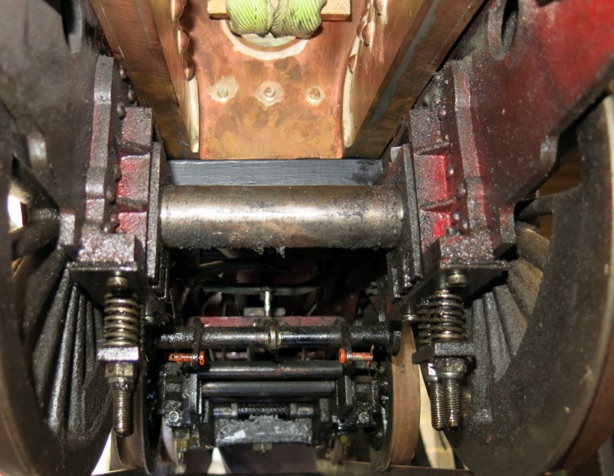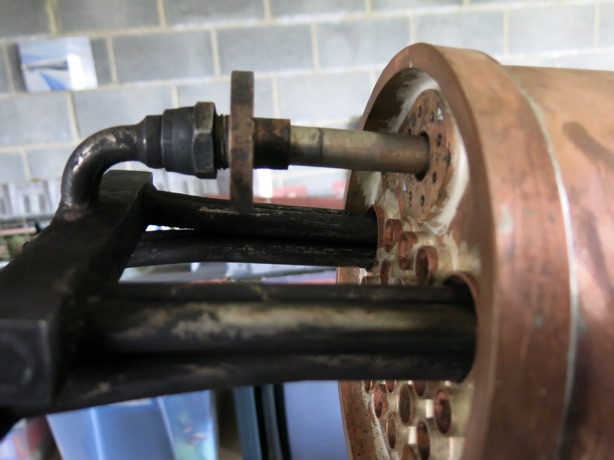REPLACING A 7.25” GAUGE LOCO BOILER
By Richard Lunn

REPLACING A 7.25” GAUGE LOCO BOILER
By Richard Lunn
BR Standard Class 2-6-4 T 4MT 80,000 class is a 7 ¼” gauge loco, built by Jess Moody in the 1980s and subsequently purchased by an ex Bristol Society member, Chris Musty, in 2003. The engine had a steel boiler which failed shortly after purchase and Chris decided that the best way forward would be to replace it with a new copper boiler. A boiler was supplied in 2018 and Chris asked me to help him put the engine back together.
I admit that I don’t know too much about locomotives and naively thought that as the boiler is not a structural part, as in a traction engine, then putting it all back together should not present too many difficulties. Wrong!
In order to clarify things and to disassociate any blame from the boiler maker I will give the reasons for the problems I am about to describe at the outset. Unknown to Chris the steel boiler was made to Jess Moody’s own design. The most common boiler for these engines is to the Jim Vass design and this is the design used by the boiler maker who had made several of these before. There are several differences between the original boiler design and the new copper one which the boiler maker tried to incorporate where possible and he did think that it would not be a straightforward swap.
At a zoom meeting, Bernard North, who is making the same loco, realized immediately that the boiler was different and anticipated the problems. Having had a separate zoom meeting with Bernard I could see that there were many other differences, including the way the boiler mounts into the loco at the firebox end.
The first problem was encountered immediately when we tried to fit boiler between the frames; it wouldn’t drop down low enough at the back. The firebox stays where they protrude were fouling on the frames.
A bit of careful fettling of the stays almost solved the problem but the frames will also need to be chamfered in the area which is curved up to match the wheel profile. That done the boiler would still not drop down far enough and this time was coming down to a hard stop. Basically the fire box was too wide and would not fit between the axle box castings.
We compared the old boiler to the new one and found that the new boiler as around 6 mm wider than the original at the foundation ring. We figured out that the axle boxes could be fettled at the top and enough material removed without compromising their strength or function. Chris looked the other way while I attacked his nice engine with an angle grinder. That done the boiler would drop down to the correct position with a little bit of clearance.
Problem solved, you think? Maybe not.

Fig 2. Shows that the frames needed to be chamfered on the inside where the frame is curved to match the wheel profile.
The boiler foundation ring rests on a ¾” square bar located between the frames. With this in position, once again the boiler was too high and investigation showed that the boiler was only sitting on one end of the bar with clearance at the other end.
Again looking at the old boiler we could see that there was a big blob of weld under one side of the foundation ring which would rest on the support bar, the bar was obviously pushed up under the boiler and its attachment holes from the frames drilled in situ, therefore the bar was not square to the frames.
The bar is held in place with a 6 mm bolt through the frames at each end. With the boiler suspended on an engine crane and held in the correct position we could see that a new bar would have very little clearance between the threaded hole and the top surface of the bar.

Fig 3. This view shows the fettled axle box castings.
Also seen are the curved chassis sections which need to be chamfered. Note the square boiler support bar.
A new support bar would need to be made but I wasn’t happy with the threaded holes being so close to the edge of the bar. I decided that the best solution would be to have a ¼” diameter hole all the way through the bar and a rod fitted through it, threaded on the ends with nuts on the outside.
I started with a 1” square bar so that the hole could be drilled further away from the edge and then the bar milled down to size. The support bar is 6” long and the long series drill wandered a bit on its way through but as I had started with a larger bar I could then hold it for milling such that in the finished article the hole was parallel to the bar in both directions.

Fig4. I started with a 1” square bar so the hole did not need to be as close to the edge.
A ¼” diameter rod was then fitted through the square bar and mounted on parallels at each end so that the rod was horizontal.
I could then machine the square bar down until the top edge was very close to the hole.
The square bar could then be turned over and machined down to the ¾” thickness.

Fig 5. View from underneath showing foundation ring now sitting on the support bar with the boiler in the correct position.
With the new support bar in position the boiler would now sit down in its correct position and we breathed a sigh of relief. Not for long though!
The superheaters and regulator need to be fitted into the boiler before it is attached to the smokebox and we did a trial fit, or in our case a trial won’t fit. The superheater will not go all the way into the superheater tubes, the superheater headers (I think that is the correct word) were too close together and fouled on the tubes. A talk with Bernard and we decided to leave out the superheater which will mean re making the wet header (again apologies if that is the wrong name) so the steam goes direct from the regulator to the steam chests.
The regulator design of the Jess Moody loco is totally different to the Jim Vass design although they both fit in the boiler in the same way.

Fig 6. This is as far as the superheater will go into the boiler. The spacing of the superheater headers do not match the distance between the tubes.
The second Covid lockdown prevented any further work and so we wait to see if the regulator will fit or if we need to make a new one. Unfortunately, Chris has no drawings of his engine.
Before the boiler failure the engine was running well and hopefully once the boiler is fitted we won’t find too many other snags. Famous last words?
To be continued as and when Covid restrictions allow…
This article is based on a Zoom meeting published in The Bristol Model Engineer.



Modelengineeringwebsite.com
the only free and the only weekly magazine for model engineers.
Editor: David Carpenter